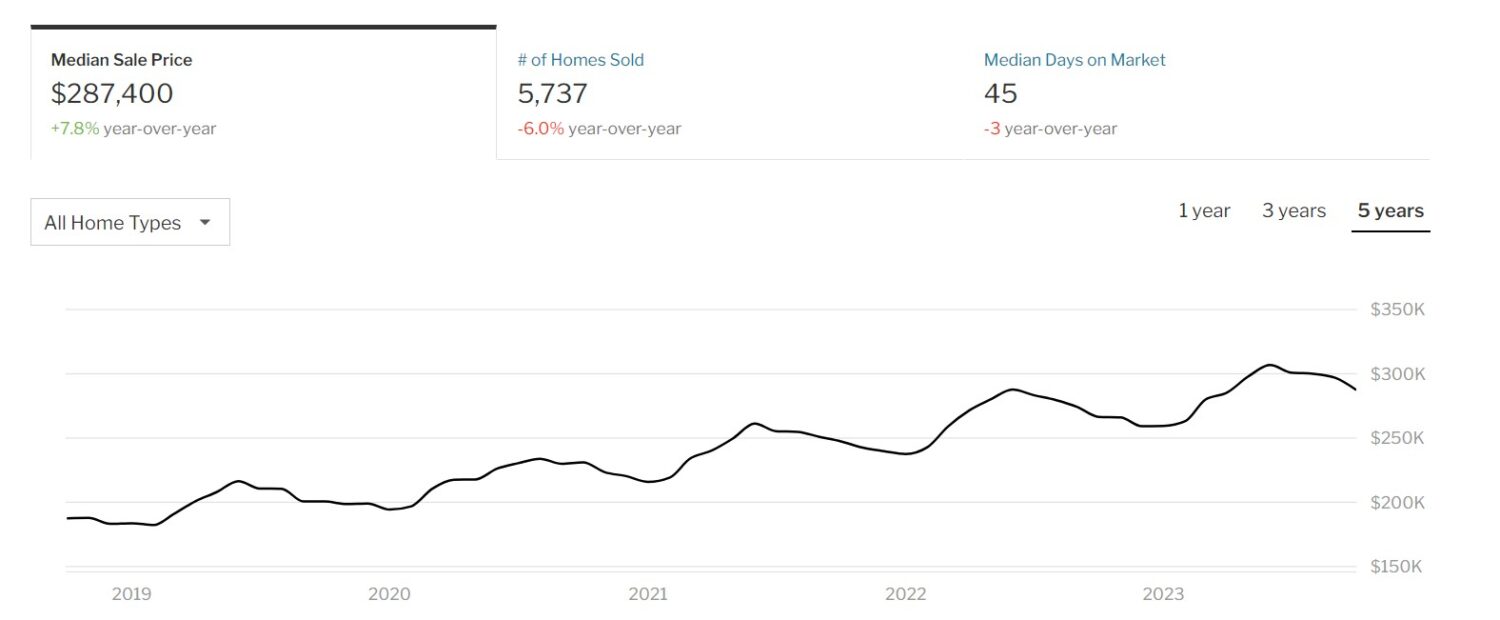Wisconsin may not have the lure of big city life, but it is loved for its scenic landscapes and simple, slow-paced lifestyle. The recent growth and wins in the Wisconsin housing market further prove that many consider it a place to call home.
As of 2021, Wisconsin had a population of 5,895,908 residents. While the COVID-19 pandemic drove many out of the state, it is on its way to recovery as more people move back in.
Given its popularity, the real estate market in Wisconsin is now influenced by increasing home prices and limited supply. This presents a good opportunity for homeowners looking to sell their homes and gain back their investment.
But buyers may also expect some good news. According to experts, buyers still have the upper hand as home sales slow down and spend longer in the market. This may lead to potential price drops and opportunities for negotiation.
The unpredictable nature of the Wisconsin housing market may present a favorable time for both buyers and sellers. If you’re interested in investing in Wisconsin property, this article will help you.
Our guide includes market trends, predictions to look out for, and invaluable tips for buyers and sellers.
Current Wisconsin Real Estate Market
As Wisconsin bounces back from the effects of the COVID-19 pandemic, its real estate market faces various challenges. These include increasing home prices, high demand and low supply, and a slowdown in home sales.
To better understand the current state of Wisconsin’s housing market, here are some important facts to take note.
Median Home Prices: Affordability in Wisconsin
As of October 2023, Wisconsin home prices increased by 8% versus the previous year. The average home price in Wisconsin is estimated at $287,900, further broken down into the following types:
- Single Family Homes: $295,000, a 7.5% increase vs. 2022
- Townhouses: $294,300, a 13% increase vs. 2022
- Condominiums: $272,900, a 10.9% increase vs. 2022
This growth indicates a strong housing market as property investments are appreciating. This may be an opportune moment for homeowners to profit from selling their property.
Inventory Levels: Supply and Demand Balance
One of the biggest factors influencing the rise in Wisconsin home prices is the imbalance between supply and demand.
Like most states, the Wisconsin real estate market is showing a growing demand from buyers.
As more people move into the state and buying power increases post-pandemic, so does the hunt for residential homes.
However, similar to the nationwide trend, the increase in demand is met by a limited supply of homes.
According to Redfin, Wisconsin homes for sale have dropped 5% vs. the previous year. As of October 2023, there are 19,720 listed homes, which accounts for two months’ worth of supply.
The reluctance of sellers boils down to several factors, high-interest rates being a significant one. Wisconsin homeowners once purchased their homes for relatively low mortgage interest rates. They are now facing a real estate industry with higher interest rates.
As such, sellers are hesitant to sell their homes in exchange for a pricier investment. Hence the limited housing supply.
Wisconsin now presents a competitive environment for buyers wherein bidding wars are a reality. As sellers have the luxury to increase their listing prices, buyers now face increasing home prices.

Sales Trends: Market Activity Pace
While this high demand-low supply scenario may signal a seller’s market, that is not exactly the case in Wisconsin.
In October 2023, data from Redfin showed that the real estate market had seen a 6.6% decline in homes sold.
This means that, although there is a high demand from buyers, many may be choosing to wait out the unstable market. Apart from increasing home prices, high-interest rates may also drive this decision.
Moreover, Wisconsin homes are taking longer to sell, estimated at 45 median days on the market.
There is no need for sellers to panic, though. This is because out of the successful home sales, 42.7% of homes were sold above their list price. 25.1% of homes were sold below their listing price. This suggests that Wisconsin is still a profitable market for sellers.
As for buyers, the slowdown in home sales may still present an opportunity. Buyers can take advantage of the situation by negotiating for lower prices. Alternatively, they may also opt to wait until home prices stabilize.
Driving Forces of the Wisconsin Real Estate Market
Given the current Wisconsin housing market trends, it is necessary to understand the factors driving these changes.
These include the economic conditions, high-interest rates, and demographic changes within the state.
Economic Indicators: Economic Conditions Impact
As with any real estate environment, Wisconsin’s economic health directly impacts its housing market.
Below are the most significant conditions that may be influencing its current state:
- Decreasing Unemployment
In 2023, Wisconsin posted a record-low unemployment rate of 2.4%. Moreover, according to the Department of Workforce Development, the state reached a record-high job count in June of this year.
- Increasing Income
As of 2022, Wisconsin had a 5.8% increase in total personal income. Moreover, the state’s median household income increased from the previous year, estimated at $73,330.
These conditions in Wisconsin result in an empowered and stable working class, which may lead to buyer confidence. Locals have more purchasing power to invest in real estate properties.
Interest Rates: Financing Costs Role
Interest rates have always played a pivotal role in real estate investment.
As of November 2023, interest rates in Wisconsin were as follows:
- 15-year fixed mortgage: 7.02%
- 30-year fixed mortgage: 7.67%
The recent surge has led to both seller and buyer reluctance, and understandably so. This is why Wisconsin has a limited housing supply and a slowdown in home sales.
Demographic Shifts: Population Trends Influence
A state’s demographics, especially population growth, migration patterns, and lifestyle, dictate real estate preferences.
In Wisconsin, the following community features may be influencing the trajectory of its housing market:
- A Growing Population: As Wisconsin recovers from its population losses over the pandemic, the influx of people moving into the state leads to a higher demand for residential homes.
- Growing Millennial Age Group: With a median age of 39, Wisconsin has a strong presence of millennials. Apart from retirees, the empowered millennial generation may be driving the growing interest in property investments in the state.

External Factors Shaping the Wisconsin Real Estate Market
Alongside state-specific conditions, the Wisconsin real estate market was not immune to the effects of recent global affairs and trends.
Here are some external factors that directly shaped the current state of the housing market.
Rising Inflation: Economic Pressures Impact
Rising inflation has negatively impacted housing markets throughout the U.S., including Wisconsin.
As costs of living rise, affordability becomes a more pressing concern. Many will focus on more urgent necessities like food, clothing, transportation, and education. Real estate rental and purchase markets become less of a priority.
Currently, the annualized inflation rate is reported at 3.6%. While it is still well above the target, this is an improvement compared to previous years. If this continues at a downward trend, real estate markets stand to see significant wins.
COVID-19 Pandemic: Changing Real Estate Dynamics
Like the rest of the world, the COVID-19 pandemic had a transformative impact on the real estate market in Wisconsin.
Perhaps the most obvious effect was the change in people’s lifestyles. The pandemic saw a shift towards remote work, the desire to be close to family, and the preference for more spacious homes.
That said, Wisconsin saw a drop in its population in 2020 up until the past year. This led to a decline in home sales and median home prices.
Fortunately, there has since been an influx of domestic and international migrants into the state. The housing market has been recovering due to the growing buyer demand and home prices.
Future Wisconsin Real Estate Market
Considering the many factors influencing the Wisconsin real estate market, it is challenging to predict the future accurately.
What remains certain, though, is that the state is reaping the rewards from its post-pandemic recovery. The growing population and increasing demand for Wisconsin homes suggest a promising year ahead.
Expert Predictions: Home Price Appreciation
Looking towards the Wisconsin housing market forecast in 2024, experts predict a continued appreciation in home prices.
However, growth may be at a more moderate pace. Compared to the current 6% increase, analysts are estimating a 4% drop.
This forecast suggests a stable investment climate for the foreseeable future. It serves as a good balance for both buyers and sellers.
Industry Forecasts: Rental Market Trends
Rental market trends in Wisconsin are expected to follow a steady trajectory.
As more people flock to the state, property demand will remain. And given the increasing home prices, renting homes is the next best bet.
Moreover, millennials in Wisconsin will always pose a steady market for rental properties.
As of 2023, the median rent price in Wisconsin is $1,437 for an 877 sq. ft. space. This is relatively lower compared to its neighboring states like Illinois and Minnesota.
While rental prices are expected to increase in 2024, Wisconsin remains a desirable destination for young people seeking independence. Thus, the rental market is predicted to stay strong.
Buyer and Seller Behavior: Shifting Market Preferences
As expected, buyer and seller behaviors will shift alongside the changes in the Wisconsin housing market.
For sellers, the growing demand from buyers will continue to allow them to enjoy many offers and profitable sales. This may result in an influx of homes for sale.
For buyers, they can continue to expect a rise in home prices. While this may mean the willingness to spend more money, buyers can expect an improvement in housing supply.
Buyers can negotiate better prices once there is a steadier balance between demand and supply. But sellers can still look forward to earning from their investments.
Whatever the case, the Wisconsin real estate market forecast for the next five years looks promising. As long as the state continues attracting residents, buying and selling properties will be worthwhile.
Emerging Technologies and Wisconsin Real Estate
As we continue to study Wisconsin housing market forecasts for 2024, several emerging trends may influence home sellers.
Smart Homes: Technological Advancements
These days, investors are placing a premium on smart homes. These technological innovations offer an enhanced living experience. It has become a factor in a buyer’s decision-making process.
Sellers may consider this trend to stand out among other real estate properties.
Co-living Spaces: Alternative Housing Options
The rise of co-living spaces as an alternative housing option reflects the changing dynamics of the real estate market.
These spaces appeal to the younger population as they offer flexible and more affordable living solutions.
For homeowners looking to rent out their properties, converting them into co-living space may attract a certain target market.
Sustainable Living and Green Building Trends
Eco-friendly homes are a preference for many buyers and contribute to long-term environmental sustainability.
As such, sellers may want to invest in sustainable and green building practices to make their properties more marketable.
Navigating the Wisconsin Real Estate Market
As we conclude our Wisconsin real estate market analysis, we’ll leave buyers and sellers with the following tips to aid in their decision-making process.
Buyer Strategies: Effective Market Navigation
As a buyer, entering the housing market in Wisconsin demands a thorough preparation.
Before you even begin exploring the market, having a budget in mind is essential. This will allow you to focus on specific homes and avoid unnecessary distractions.
When planning your budget, consider the sale price and extra costs. These include closing fees, property taxes, and maintenance expenses.
From there, securing financing is the next big step. Mortgage pre-approval offers a clear picture of buying power. It gives you peace of mind when making offers.
As you establish your financial capacities, doing market research is also a good practice. Explore different neighborhoods and gather information on location valuations. This comprehensive approach enables buyers to identify properties that align with their needs.
Working With a Real Estate Agent: Finding a Trusted Guide in the Market Maze
Navigating the complexities of the Wisconsin real estate market can be overwhelming. As such, it is best to seek guidance from a seasoned real estate agent.
Going through the process with an expert will give you insight into local market dynamics and invaluable advice.
Moreover, you will enjoy their broad spectrum of listings and professional network. With a skilled agent, they will narrow down properties based on your specific needs and preferences. This makes the home-buying journey smoother and more efficient.
Lastly, when making offers or closing deals, an agent’s negotiating skills and knowledge of legal procedures are unparalleled.
Negotiation Strategies: Making Informed Decisions in a Competitive Market
In many ways, the Wisconsin housing market is at the mercy of sellers and their luxury to dictate home prices. As such, effective negotiation is key for buyers.
Before you engage with sellers, make sure to have that between your non-negotiable criteria and aspects you are willing to be flexible with. That way, you will be willing to step away from properties unsuitable for your convictions.
Additionally, it pays to be well-informed on recent sales trends. This will give you leverage during negotiations.
Lastly, when crafting a compelling offer, consider the demands of both you and the seller. This increases your chances of reaching a deal where both parties are satisfied with the outcome.
Seller Strategies: Maximizing Returns and Ensuring a Smooth Sale
Prepping Your Home for Sale: Enhancing Curb Appeal and Market Readiness
For sellers in the Wisconsin housing market, first impressions are critical.
Investing in beautifying your home is worth investing in. It can be through landscaping, a fresh coat of paint, or minor exterior repairs. While it may cost you, it can significantly impact your home’s attractiveness to potential buyers.
The same goes for inside your home. Take the time to deep clean, declutter, and stage your home with furniture and design.
All these efforts help showcase the property’s potential and can lead to faster sales and higher offers.
Additionally, addressing any repairs or upgrades can reduce potential negotiation points for buyers. It can streamline the sale process.
Pricing Your Home Strategically: Balancing Value With Market Conditions
Strategic pricing requires a balance between current market conditions and the property’s unique attributes.
An overpriced home may linger on the market while underpricing can lead to financial loss.
Thus, when determining the price of your home, seek guidance from a broker or real estate professional. That way, you’ll have an objective approach to valuing your property.
In the end, establishing a fair price attracts more buyers. It can lead to competitive bidding, potentially increasing the final sale price.
Negotiating With Buyers: Navigating the Offer Process Effectively
Effective negotiation is as critical for sellers as it is for buyers.
For starters, sellers should be prepared for various scenarios. These include cases of many offers, low-ball offers, or requests for concessions.
Second, understanding the priorities and motivations of potential buyers can be helpful in negotiations. It’s essential to maintain flexibility while also protecting your financial interests.
Lastly, be mindful of effective communication. Seek the help of a skilled real estate agent whose expertise is a successful and satisfactory sale for both parties.
Wisconsin Real Estate in a Nutshell: A Good Opportunity for Buyers and Sellers
The real estate market in Wisconsin presents promising opportunities for both buyers and sellers.
While increasing home prices and limited supply may pose challenges for buyers, the market still shows flexibility in negotiating offers. Moreover, buyers can look forward to the predicted stabilization of prices and supply as they continue to explore.
On the other hand, sellers are poised to earn healthy profits from their homes. Despite a slowdown in sales, healthy economic conditions and growing buyer demand will continue to fuel a competitive market.
That said, when buying and selling in the Wisconsin real estate market, make sure to keep our tips in mind. Stay updated with the evolving market trends and prepare accordingly.
Lastly, consider professional guidance to help you make an informed decision. Whether you’re purchasing a home or maximizing sales returns, understanding and effectively employing strategies can lead to favorable outcomes.












